Capital City - Starigrad
Overview
Intro
In the north-western parts of the damp Boglands of the Kingdom of Ardechia lies the grandest work of Human expansion, a sprawling metropolis which was first settled ages ago during The Great Migrations. It was destroyed, swallowed by the swamps, and rebuilt back up twice over. It is a standing testament to Mankind's unyielding persistence to conquer this land, first from the Elves, then from nature itself. This is the city of Starigrad, the seat of Ardechia, and the ancestral capital of the Masonite Kingdom of old. Starigrad is considered to be the most famous and the most infamous city in Arboria, and likely beyond, as it is the place of both many great feats, as well as the place of Humanity's most terrible blunders. The city is huge, a sprawling metropolis stretching as far as the eye can see, built up through the ages on the ashes and ruins of what came before, it is a place of great wealth, and great poverty. Countless millions live within it's walls, and the majority of the city was built haphazardly, resulting in a dense urban landscape akin to a labyrinth to anyone but the locals. The city is a dark and gloomy place, as poverty and sickness plague the populace, the streets often dim and misty, buildings standing closely together and built several stories high, making it difficult for sunlight to reach the cobblestone pavement in between. Crime has always been a serious issue as well, and it is extremely difficult to track down thieves in such a landscape. The city guard are many and reasonably equipped, but they prioritise the heart of the city, it's main avenues, and official point of interest, while most of the city remains difficult to secure, both due to it's sheer size, and because of the unknown dangers that could lie behind every corner which makes guards reluctant to patrol certain sectors. Because of this, crime lords have risen in these lawless parts of the city, and the population there looks to local gangs for their protection. These parts are the poorest of the poor, the buildings old and often run down, not even the city guard see it of any value to attempt to reclaim. Like a rotten limb, it is best to cut it away from the whole, and so they bolster security at the gates leading in and out of such districts, to prevent the plague of lawlessness and decay from spilling over.Location
Starigrad sits on both sides of the great river Staya, which runs from the Messial Mountains in the east, through the Bogland and spills in to the Nord Sea in the north-west. The river is wide and navigable by ship, so the city has an expansive riverport. The river was often plagued by Heimer raiders in the early days, which is why many an old stone fortress flank the waters down stream, which in modern day are barely staffed, or were handed out to local nobles as rewards or gestures of appeasement, as the city itself grew to reach and swallow the outlying fortresses in to itself, the city effectively becoming the barrier they were supposed to be, and preventing anyone unwanted from sailing further up past it. The city lies on the outer edges of the swamps, so not too far further afield the horrible and unusable marshland gives way to lush rolling hills and fertile plains towards the west, where countless farming settlements work tirelessly to feed the immense population that Starigrad hosts. Being located in the Heartlands, the so called breadbasket of the north, certainly is a boon, if not a requirement, to sustain a city of such proportions. Directly to the west of the city stand the Pohorye mountains, a minor range in the heart of the kingdom, from which the city imports the majority of it's quarried rock and mined out ore which feed it's industry. These mountains are also the location of one of the city's prisons, located high above and dug in to the side of a mountain cliff, inspired by Dwarven strongholds. There, inmates are forced to mine out the cold heart of the mountain.Districts
The city was built over the ages in waves of expansion, the oldest district being at it's heart, and with each successive district being built around it and having it's own protective wall, which served to both integrate the growing number of buildings outside the city walls in to the city proper, as well as to segregate sections of the growing city and split it in to parts, each with their own focus, their own identity. This arrangement was as much by accident as by design, and today it plays a great part in population control and law enforcement. The most storied districts being:Old Town
The oldest district of the city, the original heart, is simply called Old Town. It is an amalgam of old buildings haphazardly built on top of one and other, and of new modern ones trying to be squeezed in between, with a stark contrast between architectural styles from building to building as techniques and fashion changed over time. As the heart of the city, it is it's prized jewel, nothing remarkable about it beyond it's storied history, but anyone finding himself owning anything within it has the pride of titling themselves as the descendants of the original settlers, claiming an ancient bloodline. Many noble families are in ownership of just an ordinary house in Old Town, just to stress this supposed heritage, and many old organisations strive to maintain some presence there for the same reasons, such as the Church of the Mason and it's chapel. It is due to this that it remains one of the most secure districts of the city, situated right next to the river Staya, with the grand Shoalsgate bridge leading across it to Ferndale district.Dayport
The Dayport district is a riverport, just north of Old Town, and it is the place where the majority of the supplies for the heart of the city arrive through by boat from up stream or from the sea rather than having to be transported by land through numerous layers of the city. As the name suggests, the port functions only in day time, for security reasons. The port is used by many of the greater trade companies and merchants, so it is heavily guarded.Stone Market
The district known as Stone Market owes it's name to it's many wide cobblestone avenues which are lined by a seemingly endless collection of stores and merchant stalls with very little room for greenery at it's heart. Located to the west of Old Town, the district is split in to two parts, proper and plaza. Stone Market Proper is the intense and crowded heart of the district where goods are brought in and sold to people who arrive from all corners of the city, while the Plaza part is a more secluded and quiet part of the district where the majority of the residentials are, with even a few parks, and the famous city Clocktower. It is one of the more secure parts of the city, with patrols being a common sight and a guard on every other corner, so one should not fear for one's safety, but at the same time, it is plagued by pickpockets. No risk, no reward, as they say.South Quarter
The district simply designated as South Quarter would be completely unremarkable as any other purely residential focused district in the city, were it not for the grand Saint Elder's Cathedral of the Church of the Mason. It is one of the older parts of the city, built amidst one of it's population booms, which it certainly shows through it's labyrinthine layout and rushed cheap housing. But, in this population boom, the Church saw to situate itself in the heart of a rapidly growing population centre, and planned to erect one of it's greatest places of worship in the realm that towers above the rest of the district, and through which the Order would exert it's influence. South Quarter lies just south of Old Town, and it is generally still considered at the heart of the city. Living here is fairly safe, but the security of the district is almost entirely delegated to the Masonite order.Ferndale
The district just across Shoalsgate Bridge from Old Town is Ferndale, the cultural heart of the city. It's layout is surprisingly well planned for a district so close to the city centre, and it is where the majority of the residence are better off, and where much of the lower nobility and merchant class reside. Trees and other greenery decorate the outer edges of it's broader avenues, and there are a few parks scattered about, with open squares playing host to cultural and administrative institutions both. The district has a famous museum of history and modern technology, an opera house and theatre, a chapel, a library, a public bath house, a grand hotel, and one of the most secure banks in all of the city. It is reasonable to assume that Ferndale is one of the most secure districts in Starigrad, second only to Hightown.Hightown
The rich part of the city, Hightown is named as such both due to it's elevation, as it is situated on slopes of Valewood Hill and overlooks the sprawling city below, as well as because the majority of it's residence are higher nobility. The streets are wide, well lit, with plenty of décor and greenery, heavily guarded, and flanked by mainly lavish manors and villas of only the most wealthy and influential in the city and the realm at large. Hightown is where the city's main administrative institutions are, such as the Town Hall, and the Court of Law.Cinderfell
The industrial district of the city. Cinderfell is situated on the northern banks of the river Staya, north of Dayport. It is where the brightest most innovative minds of Ardechia work with the Messial Dwarves, people who have found a new home in this Human realm and have adopted their faith, work together to industrialise and increase efficiency of production to meet the city's ever growing demands. It is a grim and dark place where the air is full of smoke and ash as factories spew out clouds of darkness as great furnaces burn to turn the wheels of production. As the leading preacher of industrialisation and the worship of the forge and fire, the Church of the Mason holds great influence here.Other points of interest
Wayport to the west of Cinderfell is a poorer less regulated port that functions day and night and is notorious for it's many sea side taverns and inns, as well as gang activity. East Quarter is one of the poorest districts in the city, with the majority of it's population in poverty, yet they still somehow manage to get by through an intricate hierarchy of servants and masters in underground organisations. Mirk Town is an outlying district of the city to the east which used to be it's own settlement before being swallowed by the growing capital. It already was on soft marshy soil, but as the city expanded and new stone buildings were erected in place of wooden shacks, many of them were built without the needed base and as such partly sunk in to the ground, resulting in a ruined, wet and muddy, extremely poor and sickness plagued district. Valewood Hill is the location of the Royal Palace where the King and his family reside. The palace is a grand castle built atop the hill which overlooks the sprawling city below and is a vast complex. The Wailing Isle is the city's main prison complex sitting on a solitary isle in the middle of the great Staya river. Breaking out is said to be impossible, as the currents are too rapid and too cold for any escapee to ever manage to cross. Shoalsgate Bridge is the largest and longest bridge that connects the city on both sides of the river. It is so large and wide, that during the city's era of overcrowding, residential housing was built along it's length with the space for a street left clear down the middle. The Undercity is the sunken remnants of what came before. First an ancient Elven city destroyed during the Masonite Crusade, then a Human city destroyed by the Witch Queen towards the end of The Great Migrations. The current city was simply built over the ruins of the old ones, and their remains can still be found, sunk in to the soft soil over the ages, if one ventures down through the sewers. These secluded and unexplored places are breeding grounds for criminal activity, a sanctuary for witches and other deviants, and are stalked by underworld beasts. The tunnels of the Undercity are vast, expanded upon even after their downfall, and no one truly knows how deep they go.
Type
Capital
Location under
Included Locations
Owner/Ruler
Owning Organization
- Shoalsgate Bridge image is a screenshot from the game Thief 4
- Other imagery generated by Midjourney

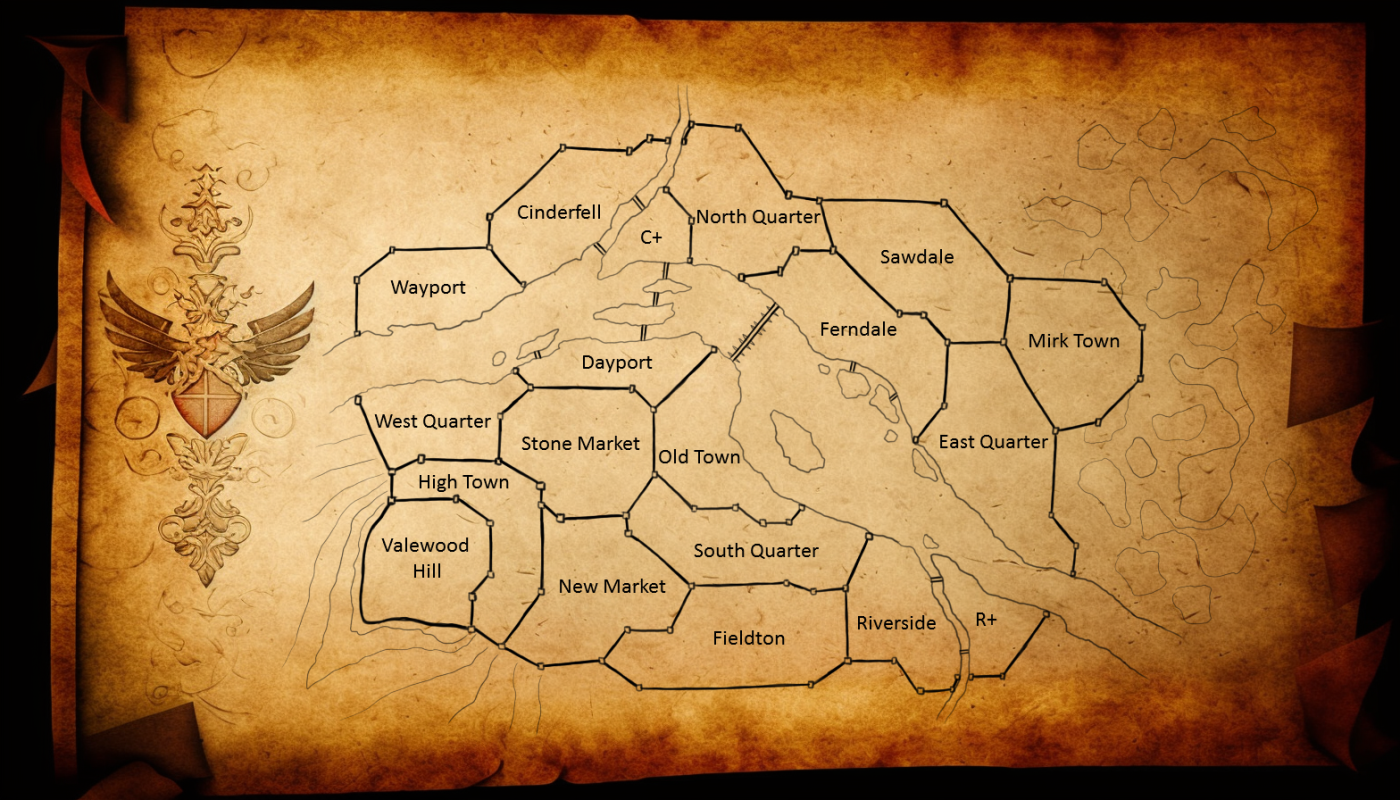
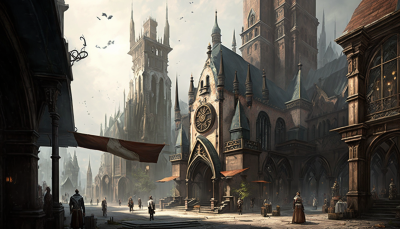
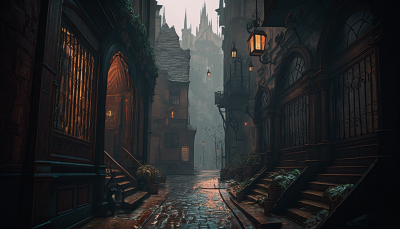
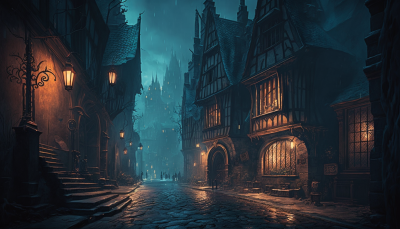
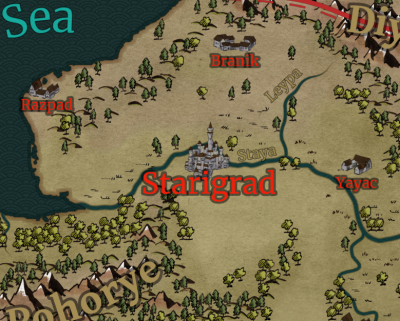
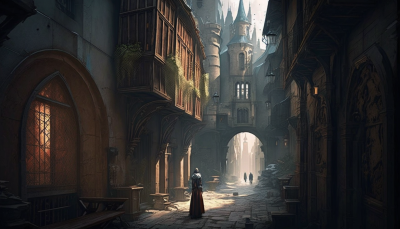
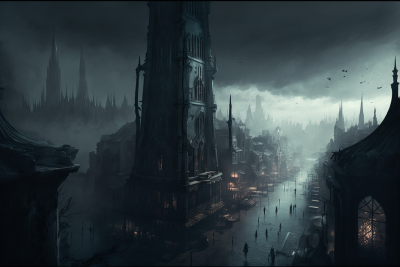
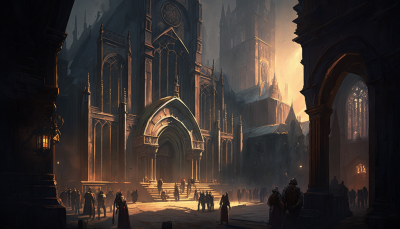

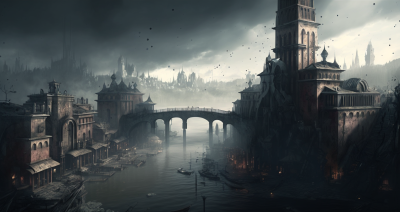
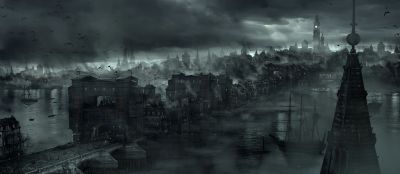
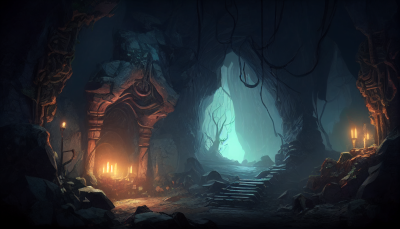

Comments